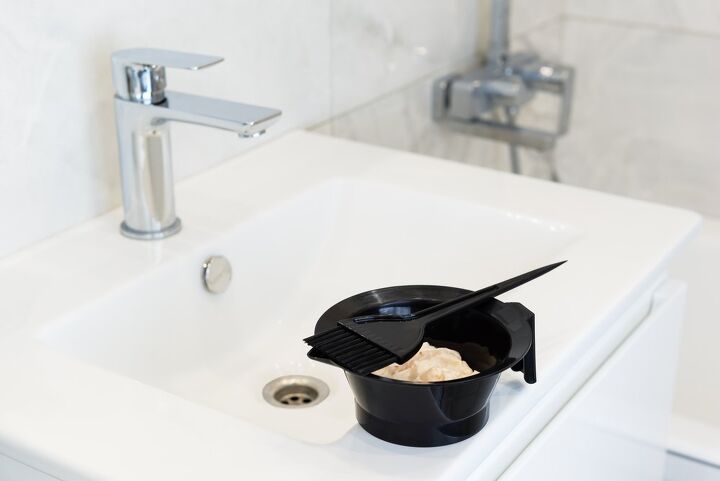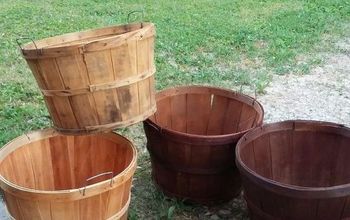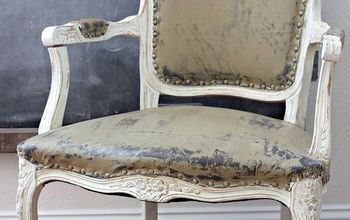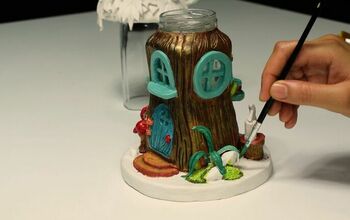How to Remove Hair Dye From Your Sink (and Other Bathroom Surfaces)

By Hannah Twietmeyer
If your angsty teenage years didn’t introduce you to DIY hair dye products, then there’s a good chance quarantine probably did. Switching up hair colors between seasons, brightening or darkening tones, or adding a pop of bold, semi-permanent color are popular cosmetic trends, but salon prices and upkeep are not cheap. Of course, at-home hair coloring products are conveniently sold at stores all over and can help you achieve the look you’re going for at a much lower cost. Unfortunately, they’re also considerably effective at staining sinks, tiles, and other bathroom surfaces.
If a recent at-home hair treatment left your bathroom sink with some unwanted color, don’t shop for that sink upgrade just yet. There are several tricks—both natural and chemical—that you can try, and with the right supplies and a little elbow grease, you should be able to completely remove hair dye from your sink and make your bathroom shiny-clean. And if you’re thinking about dying your hair at home, we also have tips on how to prevent dye stains in the first place.
Photo via Shutterstock
How to Remove Hair Dye Stains from Sinks with Liquid Dish Soap
You’ll likely have some liquid dish soap on hand, so this is a great place to start. The soapy, foamy suds that you use to scrub food and grease stains from pans and plates can gently work to lift color from the dye stains in your sink. Note: This method works best on fresh stains.
Tools and Materials Needed
- Liquid dish soap
- Rag or sponge
Step 1: Cover the Stain
Take your dish soap of choice and cover the stained area, lathering gently with a rag or sponge. Be mindful not to wipe fresh dye color all over your sink.
Step 2: Let the Stain Soak
Sit back and let the dish soap saturate the stain for some time, between five and 10 minutes.
Step 3: Rinse and repeat
Thoroughly rinse the soap from the stained area. Some stains can set when introduced to hot water, though when rinsing dye from hair, hot water actually fades the color out quicker. Try using warm water first to rinse the detergent and dye from your sink, and if it washes well then it’s probably safe to up the heat. Repeat the saturating and rinsing process as needed.
How to Remove Hair Dye Stains from Sinks with Rubbing Alcohol or Nail Polish Remover
Both rubbing alcohol and nail polish remover are common household products that can double as dye cleaners. If you have some tucked away in your medicine cabinet, save yourself a trip to the store and try these solutions to cleanse hair dye from your sink.
Nail polish remover contains acetone, a solvent that is very effective in breaking down materials like paint, grease, and varnish in addition to the obvious nail polish.
Rubbing alcohol—depending on the strength and percentage diluted—has a number of uses. Solutions with a lower isopropyl alcohol content, often 70 percent, are often used to sterilize bug bites and piercings, according to Medical News Today. The tough, high-grade stuff, either 99 percent or even 100 percent isopropyl alcohol, can be used to effectively remove stains from hard surfaces in bathrooms, as well as windows and stainless steel. It works also as a disinfectant on many surfaces, but steer clear of wood, especially if it’s treated, varnished, or painted. Rubbing alcohol can literally dissolve and liquefy the finish on your wooden furniture. Also, keep in mind that rubbing alcohol is strong stuff that needs to be used properly; keep it away from flames and bleach and use it in well-ventilated areas. There are many ways to use rubbing alcohol in your home, but make sure you do so safely.
Tools and Materials Needed
- Absorbent rag or paper towels
- Acetone-based nail polish remover or high percent rubbing alcohol
- Cotton ball or cotton pad
Step 1: Dry Up Any Remaining Water
Use an absorbent rag or some paper towel to soak up any excess water in your sink. You want to leave as dry a canvas you can for the rubbing alcohol and nail polish remover to get to work!
Step 2: Grab a Cotton Ball or Two
Generously soak a cotton ball or cotton pad with either rubbing alcohol or an acetone-based nail polish remover. If you have 70 percent isopropyl rubbing alcohol in your medicine cabinet, give it a try. You can always opt for a higher percentage solution if it doesn’t lift the entire stain.
Step 3: Wipe
Once you’ve saturated a cotton ball with your solution of choice, all you need to do is use it to wipe the stain clean. If remnants of the stain are still there, repeat the process with another soaked cotton ball until the stain is completely removed from your sink basin. Note: This method will likely remove lighter stain colors. If the dye stain is black, it may lighten but not fully remove the color. If that’s the case, opt for another method.
Photo via Tara
How to Remove Hair Dye Stains from Sinks with Vinegar and Baking Soda
You’ve probably had both vinegar and baking soda in your house cleaner lineup for some time, as they’re each effective on their own when it comes to disinfecting surfaces and helping airing out a smelly refrigerator. And when combined, the cleaning power doubles.
Baking soda works as an alkaline abrasive to dissolve materials, while the high acidity in vinegar breaks down stains. To attack hair dye stains directly, mix parts vinegar and baking soda until it reaches a paste-like consistency.
Tools and Materials Needed
- Bowl or cup
- Vinegar
- Baking soda
- Old toothbrush or rag
Step 1: Create a Paste
Add vinegar and baking soda to a bowl or cup and mix until a paste is formed. You don’t want it to be concrete-thick, but it shouldn’t be runny.
Step 2: Apply Paste to Stains
Using an old toothbrush or rag, take some of the vinegar and baking soda paste and apply it directly to the hair dye stains in your sink. Scrub the stains from the surface until the color is lifted.
Step 3: Rinse and repeat
Rinse the area with water and repeat if necessary.
How to Remove Hair Dye from Sinks with Bleach
If gentler methods are struggling to remove hair dye stains from your sink, it might be time to break out the bleach. It has whitening, brightening, and bacteria-killing capabilities, and is often used on the toughest of stains.
Handle bleach carefully, in a well-ventilated space, and while wearing rubber cleaning gloves.
Tools and Materials Needed
- Rubber cleaning gloves
- Plastic container or glass jar
- Bleach
Step 1: Make a Bleach and Water Solution
For most sink stains, combine equal parts bleach and water in a plastic container or glass jar to create your own cleaning solution. Some jobs may require more bleach, sometimes even pure bleach. If that’s the case in your sink, pour carefully, as bleach can irritate skin, eyes and damage clothes. It can also destroy furniture, so handle the product with caution.
Step 2: Let the Stain Soak
Carefully pour the solution onto the stained area. Once you’ve fully covered the area, let it sit for 15 to 30 minutes.
Step 3: Rinse
After the bleach has had some time to work, thoroughly rinse the stained area in your sink with water. If you used a more diluted solution, you may want to grab a sponge and scrub the stain to help lift any stubborn color particles from the sink’s surface (via Design Swan).
How to Remove Hair Dye from Bathroom Counters
If hair dye has spread to your bathroom counter, you can lift the stains with the use of a baking soda solution.
Keep in mind that because bathroom counters come in a range of materials and surfaces, you should avoid using harsh chemical treatments as cleaning agents unless the product specifies otherwise—you don’t want to ruin those beautiful countertops.
Tools and Materials
- Bowl or cup
- Baking soda
- Warm water
- Gloves, rag, or an old toothbrush
- Sponge or cloth
Step 1: Create a Paste
Mix 1-2 tablespoons of baking soda and with warm water in a bowl or cup, adding just enough water so that the mixture forms into a paste. You don’t want it to be too runny; aim for a consistency similar to toothpaste.
Step 2: Apply Paste to Stain and Wait
Use gloves, a rag, or an old toothbrush to apply the paste all over the stained area. Let the solution sit on the stain for an hour, give or take.
Step 3: Remove the Baking Soda Solution
Dampen a sponge or cloth and wipe away the baking solution from the stained area. That’s it! If the stain partially remains, repeat the process until it is completely lifted.
How to Remove Hair Dye from a Bathtub
If your bathtub is made from a similar surface to your sink—likely fiberglass or porcelain, according to The Home Depot—you could try any of the methods mentioned above for removing hair dye stains. They’re best for spot treatments, but if much of the surface area of your tub is stained with dye, try the cleaning hack below.
Tools and Materials Needed
- Vinegar
- Baking soda
- Rubber cleaning gloves or stirring utensil
- Sponge
Step 1: Fill Your Bathtub
The first step to a clean, hair dye-free bathtub is to fill it with water. Plug the drain and let the tub fill with hot water until the stains are completely submerged.
Step 2: Add Vinegar and Baking Soda
Add one cup of vinegar to the hot water and mix with either gloved hands or a utensil of some sort. Then add half a cup of baking soda. The water will fizz, which means the baking soda is taking action on those stubborn dye stains. Let the solution sit for about 10 minutes.
Step 3: Drain and rinse
Once the solution has gone to work on the tub, drain it. Then, rinse with warm water until the basin is washed completely. If remnants of dye remain, use a sponge to scrub them off of the tub’s surface.
Photo via Angela
How to Remove Hair Dye from Bathroom Tile Grout
Tile grout in your bathroom requires a little more care, as they hold stains easier than countertops and sinks and are sensitive to certain chemicals. If hair dye stains the grout in your bathroom, you have two options. The first is to clean it using a grout deep cleaner.
Tools and Materials Needed
- Clean cloth
- Grout deep cleaner
- Tile and grout brush or old toothbrush
- Cloth
- Grout pen (optional)
Step 1: Prepare the Space
Wipe the tiles and grout with a clean cloth, mopping up any wet dye from the surface so you can see the stains properly.
Step 2: Apply the Grout Cleaner
Follow the directions on the back of the cleaning product for application. Some more concentrated products may have you mix the cleaner with a cup of warm water.
Step 3: Let the Cleaner Sit
It’s important to not remove the cleaner right away. Let it work on the grout stains for a few minutes to thoroughly lift the dye.
Step 4: Scrub and Rinse
Grout cleaner is tough stuff, so you may not even have to scrub the stains. But if you find that there is some remaining stain left, use an old toothbrush or a tile and grout brush to do the job. Then, remove the cleaner from the grout with warm water and a cloth.
If hair dye persists on the grout after repeating the above cycle, your second option is to consider purchasing a grout pen. This will add a dyed waterproof line to your grout, covering any stain. Grout pens come in a wide array of colors, so you can find the perfect match to hide hair dye stains for good. Simply find the color that’s right for your grout, and follow the application instructions that come with the product.
How to Prevent Hair Dye from Staining Your Sink
The simplest way to keep your sink free of hair dye is to eliminate the chance for stains in the first place. There are a few ways you can prevent hair dye from staining your sink:
- Use saran wrap. Before starting your hair dye process, line your sink or tub with a layer or two of saran wrap—the plastic stuff you probably have in a kitchen drawer somewhere. Poke a little hole over the drain so things can rinse properly. Then, when you’re finished coloring your hair, carefully remove the saran wrap and toss.
- Cover the surfaces in soap prior to dying your hair. Use a liquid detergent soap to coat the inside of your sink or bathtub before you dye your hair. When you’re finished, the soap should prevent stains from setting on the surface, so you should be able to rinse everything down the drain with some warm water.
- Line the sink and tub with petroleum jelly. Similar to using soap, a layer of Vaseline will help prevent dye from coloring your sink—and your skin, if you’re applying the color too liberally. Use a clean cloth to apply the jelly to the surfaces of your sink or tub, and rinse when finished. Make sure to rinse well; you don’t want to slip next time you take a shower.
Been there, done that with hair dye sink stains? What helped you get rid of them? We’d love to hear in the comments below!


























Frequently asked questions
Have a question about this project?